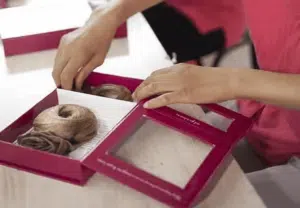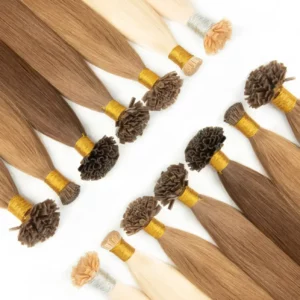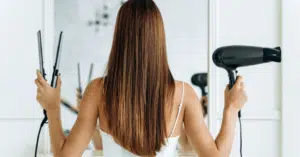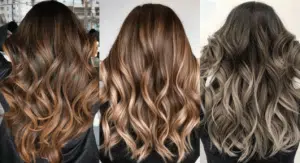Clients want perfect color that blends in seconds. The wrong move ruins softness, shine, and lifespan. The right plan delivers tone-on-tone harmony and happy repeat orders.
Yes, you can color 100% human-hair halo extensions with careful, deposit-only work. Do not bleach. Run a strand test first. Use low-volume, professional color. Keep products off the wire and base. Rinse cool, condition ends, and air-dry flat.

This guide answers the big question, shows pro-level workflows, explains risks, and offers safer ways to match color without heavy processing. Share it with stylists and retail teams to standardize service and protect margins.
Can you color halo extensions?
You want a seamless match without damage. You also want the hair to stay soft after styling and washing.
You can color halo extensions if they are 100% human hair, full cuticle, and if you use deposit or demi-permanent tones. Avoid bleach and high-lift. Always test a small swatch first and monitor porosity and slip.
Dive deeper
Know the fiber before you mix
- Human hair, full cuticle: Best for gentle deposit. The cuticle aligns and resists roughness.
- Remy but not full cuticle: Still workable for light deposit, but expect faster fade.
- Synthetic or heat-resistant fiber: Do not color. Pigment will not take.
- Pre-toned/platinum halos: Already processed. They accept very mild deposit or purple-blue corrective toners. They do not tolerate lift.
Base shade decides the risk
- Very light blondes (level 9–10): Highest risk of dryness or over-absorption. Keep to sheer, acidic demi at low volume.
- Mid blondes to light brunettes (level 7–8): Accept gentle deposit and glazing well.
- Medium to dark (level 3–6): Accept warm or cool deposits easily; watch for banding if hair was previously colored.
| Goal | Safe approach | High-risk approach (avoid) |
|---|---|---|
| Neutralize brass | Acidic demi toner, 5 vol, 5–10 min | Strong purple shampoo soak |
| Deepen one level | Demi deposit, 5–10 vol, 10–15 min | Permanent color with 20 vol |
| Add soft lowlights | Diluted demi + clear, foiled on board | Direct dyes with metal salts |
| Lift 1–2 levels | Not recommended on halos | Bleach or high-lift |
A halo must survive frequent on/off and brushing. Keep chemistry gentle so the cuticle stays smooth and the client’s ROI stays high.
Should a salon color halo extensions?
Clients ask for salon help. You need a clear policy that protects the hair and your warranty.
A salon can color halos safely with pro tools, strand tests, and controlled timing. We advise deposit-only services, signed waivers, and strict aftercare. This protects hair quality and brand reputation.
Dive deeper
Service policy that works
- Pre-check: Confirm hair is 100% human and not coated with heavy silicones. Clarify gently if needed.
- Strand test: Remove one hidden bundle fiber or use a 1 cm slice at the nape edge. Record timing and result.
- Waiver: Note “no bleach, no lift,” expected fade curve, and aftercare rules.
- Board work: Always color off-head on a mannequin clamp or color board. Keep color away from the halo wire and base stitching.
- Timing: Under-process on purpose. You can glaze again; you cannot reverse over-tone on fragile blondes.
- Finish: Rinse cool, condition mids–ends, blot, air-dry flat. No vigorous rubbing.
Why this protects profit
Replacements erode margins. A simple policy with deposit-only formulas preserves the cuticle and keeps grams intact. It also sets clear client expectations, which keeps reviews strong and returns low.

How to color halo extensions safely?
You need precise steps. Guesswork leads to stain lines, dryness, or uneven tone.
Use a deposit-only workflow: prep, strand test, mix, apply on board, process gently, rinse cool, condition ends, and dry flat. Keep chemicals off the wire, knots, and stitching.
Dive deeper
Tools and prep
- Color board or mannequin clamp
- Nitrile gloves, tint bowl/brush
- Professional demi color + 5–10 vol developer (or acidic toner)
- Plastic wrap, clips, microfiber towel
- Sulfate-free shampoo, light conditioner, wide-tooth comb
Step-by-step
- Detangle dry hair from ends up. Lay the halo flat with the weft spread evenly.
- Section the weft into 3–4 manageable zones with clips.
- Strand test on a small hidden slice. Time to target tone.
- Mix demi color. For lowlights, dilute with clear to keep softness.
- Apply on the board, painting mid-lengths first, then ends, then lightly feather toward the top. Keep 1 cm away from base stitching.
- Saturate evenly. Flip and repeat on the reverse. No puddles near knots.
- Process per strand test timing. Check every 3–5 minutes.
- Emulsify with a few drops of water and glide through to even tone.
- Rinse cool until water runs clear.
- Shampoo lightly if needed. Condition mids–ends.
- Blot with microfiber. Lay flat on a towel. Air-dry 80–90%, then finish with a cool blow-dry from a distance.
- Seal with a lightweight leave-in. Avoid roots and base.
Formula tips
- To cancel yellow: violet-based toner; to cancel orange: blue-based toner.
- To deepen: natural or neutral-warm demi at one shade darker than target.
- Avoid permanent dyes and 20 vol. The gain is small, the risk is high.
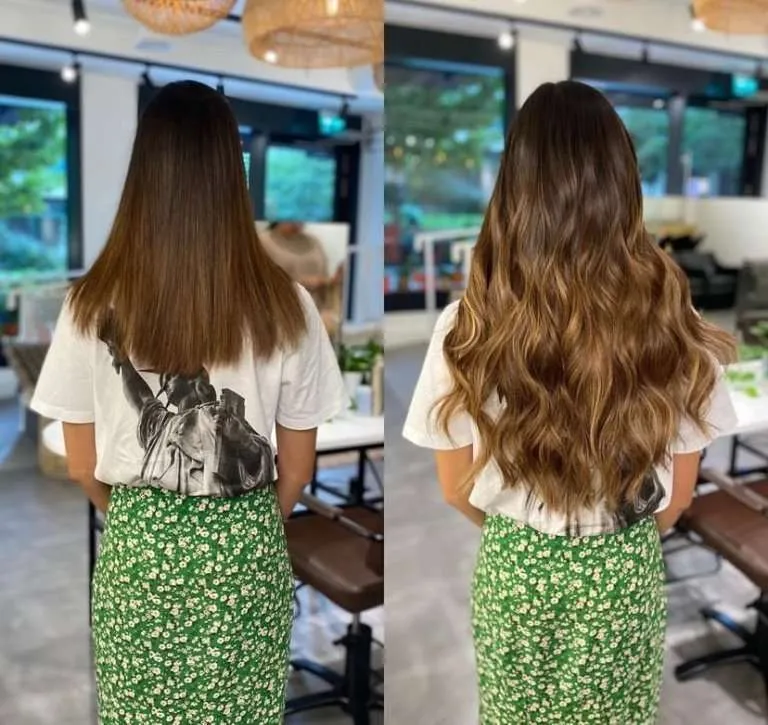
What happens if you color halo extensions?
You change porosity and slip. You may fix brass. You may also reduce lifespan if chemistry is too strong.
Coloring can improve tone and depth, but over-processing dries cuticles, increases tangles, and causes faster fade. Bleach risks breakage and frizzing. Metal-salt dyes can stain permanently and block future services.
Dive deeper
Typical outcomes
- Light deposit/glaze: Better tone, more shine, mild slip increase.
- Over-tone on 10 levels: Ash cast, dull ends, rough feel.
- High-lift/bleach: Elasticity loss, white spots, breakage at ends.
- Box dye with metals: Permanent staining, unpredictable lift next time.
| Action | Likely result | Fix |
|---|---|---|
| Gentle demi glaze | Soft tone, minimal damage | Re-glaze in 4–6 weeks |
| Over-toning (too ashy) | Dull cast, lifeless finish | Clarify once, re-tone warmer |
| Bleach on halo | Dry, frizzy, shedding ends | Trim, bond-building mask, no more lift |
| Metallic/box dye | Staining, reaction with pro color | Avoid future chemistry; replace if needed |
Your goal is not lift. Your goal is tone control with maximum fiber preservation.
How can I match color without dye?
Clients want harmony fast. You can often match without chemistry.
You can skip dye by selecting the right shade family, blending two halos, adding lowlight clip-ins, or using heat styling and parting tricks. Simple adjustments often outperform chemical work.
Dive deeper
Non-chemical strategies
- Two-shade blend: Layer a base halo + a few narrow clip-ins one shade deeper for instant dimensional lowlights.
- Root smudge illusion: Use a small amount of temporary root powder at the part for depth without touching the halo.
- Texture match: Curl natural hair and halo together in the same pass to merge tones visually.
- Parting: A zig-zag or soft side part hides micro tone shifts.
- Face framing: Add two clip-in pieces near the front in a warmer or cooler shade to steer overall tone.
| Need | Fast solution |
|---|---|
| More depth at root | Temporary root powder or eyeshadow |
| Neutralize slight warmth | Cool-toned styling spray (non-permanent) |
| Add dimension | 2–4 slim lowlight clip-ins beneath the veil |
| Blend ends | Cut soft point-cuts and bevel with hot brush |
These options protect fiber quality and keep your warranty intact.
What should you never do when coloring halos?
Some actions destroy softness in one session. Avoid them completely.
Do not bleach. Do not high-lift. Do not use metallic box dyes. Do not soak in purple shampoo. Do not color on the head. Keep chemicals off the wire and base. Do not over-process.
Dive deeper
- No bleach or high-lift: Halos often start as processed hair. More lift breaks ends and wrecks cuticle.
- No metal-salt dyes: They block future services and can react with pro color.
- No purple-shampoo soaks: Uneven patching, dry tips, and dull cast.
- No on-head coloring: Stains the base, swells knots, weakens stitching.
- No heavy oils before coloring: They resist deposit and cause banding.
- No hot water rinses: They open cuticles and speed fade.
A simple “NO list” saves stock and protects client results.
Aftercare for colored halo extensions?
Color looks best when the cuticle stays smooth. Aftercare keeps that finish.
Use sulfate-free shampoo, cool rinses, and light conditioners on mids–ends. Avoid oils at the base. Air-dry flat when possible. Use heat protectant and moderate heat only.
Dive deeper
Wash routine
- Frequency: Every 10–15 wears or when product builds.
- Shampoo: Sulfate-free, small amount, focus on lengths.
- Rinse: Cool water to help cuticle lay.
- Condition: Mids–ends only; keep 1 cm from base stitching.
- Dry: Blot, lay flat, air-dry 80%, finish cool.
Styling
- Heat: 160–185°C (320–365°F) max with protectant.
- Curl pattern: Curl halo and natural hair together for one pattern.
- Storage: Silk bag or hanger, ends protected, no tight clips at the base.
| Risk | Prevention |
|---|---|
| Fading | Cool water, UV shield, less frequent washes |
| Dry ends | Lightweight leave-in on ends only |
| Tangles | Wide-tooth comb, start at ends |
| Base wear | Keep products away from wire and stitching |
Consistent, gentle care extends life and keeps the color true.

My opinion
From a manufacturer’s view, deposit-only work is the ceiling for halos. I design halos for frequent on/off cycles and retail ease, not for chemical lifts. When you need color correction, pick targeted toners, micro lowlight clip-ins, or better shade curation at purchase. This keeps the hair soft for 9–18 months and protects your brand’s promise.
FAQ
Can you bleach halo extensions?
No. Bleach risks breakage and voids most warranties.
Can I tone platinum halos?
Yes, with gentle violet/blue acidic toners. Watch them closely. Rinse early if needed.
Will color affect the wire or base?
It can. Keep chemicals off the wire, knots, and stitching to avoid swelling or stains.
Can I use box dye?
No. Many contain metals and strong alkalinity that damage fibers.
What if the color is too ashy?
Clarify once, then re-glaze with a warmer demi diluted with clear.
How do I match without dye?
Blend two close shades, add lowlight clip-ins, curl together, and adjust parting.
Do purple shampoos work on halos?
Spot use is fine. Do not soak. Patchy, dry results are common.
Do halos made of full cuticle hair color better?
Yes. They accept deposit predictably and keep smooth cuticles longer.
Conclusion
Color halos only with gentle deposit methods, never with bleach. Test first, paint off-head, avoid the base, rinse cool, and care lightly. Soft chemistry protects shine and lifespan.
Hibiscus Hair Manufacturer has been dedicated to producing high-quality hair extensions for 25 years and is a recognized leader in the industry. If you are interested in finding a reliable hair extensions supplier and wholesale for your brand, please visit our website for more information:
HOME

